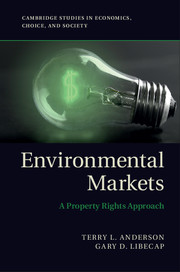Book contents
- Frontmatter
- Contents
- List of Figures and Tables
- Preface
- Acknowledgments
- 1 Who Owns the Environment?
- 2 Is Government Regulation the Solution?
- 3 Property Rights for the Common Pool
- 4 Local Property Rights to the Commons
- 5 The Politics of Property Rights
- 6 From Property Rights to Markets
- 7 Tackling the Global Commons
- 8 Property Rights and Environmental Markets
- Index
- References
5 - The Politics of Property Rights
Published online by Cambridge University Press: 05 July 2014
- Frontmatter
- Contents
- List of Figures and Tables
- Preface
- Acknowledgments
- 1 Who Owns the Environment?
- 2 Is Government Regulation the Solution?
- 3 Property Rights for the Common Pool
- 4 Local Property Rights to the Commons
- 5 The Politics of Property Rights
- 6 From Property Rights to Markets
- 7 Tackling the Global Commons
- 8 Property Rights and Environmental Markets
- Index
- References
Summary
When property rights to valuable environmental and natural resources exist, there are many potential benefits. It is possible to restrict competitive entry to avoid the losses of open access, to encourage long-term investment in the resource (including conservation), to promote exchange, which can channel the resource to higher-valued uses, and to avoid wasteful and potentially divisive conflict that occurs when valuable resources are open to all. Property rights – common and private – are useful as alternatives to government regulation for many environmental and natural resource problems. They may be the low-cost option, relative to regulation or tax policies, and they may better align users’ incentives with conservation or other mitigation goals.
Even with these advantages, property rights often are resorted to late in resource use after many of the rents have been dissipated from excessive exploitation. For example, in 1973, fishery economist Francis Christy called for the use of individual transferable quotas (ITQs) as property rights to the right to fish within an overall total allowable catch (TAC) to avoid overfishing. Serious adoption of ITQs did not occur for some 20 years when they were put into place in Iceland and New Zealand. Similarly, the notion of tradable emission permits as property rights to reduce air pollution was put forward by Thomas Crocker in 1966 and by J.H. Dales in 1968, but their adoption also took another 30 years. Further, when property rights are adopted, they often are limited. ITQs and emission permits in the United States are not legal property rights subject to takings protection, but use rights, subject to reassignment or termination by the government. Trading in ITQs is restricted to certain parties and the quantity of quotas that can be held. These limitations on property rights reduce the ability of environmental markets to more fully address the losses of the common pool. The question is why? In this chapter, we explore the political economy of property rights.
- Type
- Chapter
- Information
- Environmental MarketsA Property Rights Approach, pp. 113 - 133Publisher: Cambridge University PressPrint publication year: 2014



